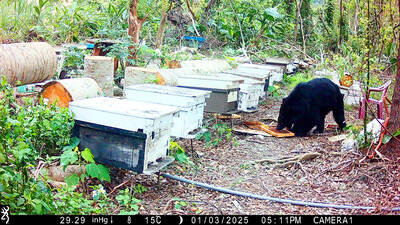Six lengths of bamboo and some string was the only thing between Wang Qiu-liang and the raging waters below her.
Slipping off the makeshift bridge and falling into the powerful waters would likely be fatal. But a week after Typhoon Morakot destroyed the concrete footbridge that had connected the 53-year-old’s village to the outside world, Wang decided she would risk anything to get to the village and search for her missing loved ones.
Nearby, rescue workers watched in frustration, unable to stop Wang and others crossing the bridge to get to Hsinfa (新發) in Kaohsiung County.
“I don’t care about the danger. I just want to see my people. Four members of my family were buried alive and there are 10 more still trapped there,” Wang said, tears streaming down her face as she pointed to the hill across the river.
On the other side, broken roads, flattened plantations and endless swathes of rubble awaited Wang, one of the first to cross the bamboo poles.
“What they are doing is extremely dangerous,” fireman Kevin Kuo said. “The mudslides can return any time if the rain upstream gets heavier.”
“But how can we stop them from going to find their relatives?” he asked as he filmed the villagers crossing the bridge with a hand-held camera as documentation in case of them were swept away.
Before they built the bamboo bridge, some villagers had tried wading across the river, but rescuers pulled them from the waters as the rapids threatened to sweep them away.
Elsewhere, the magnitude of destruction has left its mark everywhere in Liukuei Township (六龜).
“I haven’t gotten proper sleep for such a long time. It is going to take us a long time to rebuild this town,” a weary-eyed police officer said.
Meanwhile, a policeman in Liukuei who was airlifted to safety after being stranded on the roof of his police station for four days, said he had survived by not losing hope, praying and holding onto a steel beam to withstand the floodwaters.
Chang Hui-cheng (張輝政), resting in a hospital after being rescued last Tuesday, said the ordeal started when Morakot began dumping heavy rain on his village of Nansalu (南沙魯) in Namasiya Township (那瑪夏).
He said he persuaded tourists in the area to leave as soon as possible, and they all followed his advice. But villagers were reluctant to evacuate, saying that Jesus Christ would take care of them, Chang said.
Chang said he tried to get some rest after helping with evacuation efforts, but the storm soon broke windows on the first floor of the police station.
Realizing the danger of flooding, he ran up to the roof of the three-story building, where he huddled in his raincoat and held onto a steel beam to prevent himself from being washed away by the floodwaters.
During his four-day ordeal, Chang said he was exhausted but knew that relaxing his guard could be fatal.
“The waterproof raincoat saved my life, as it kept me warm,” Chang said.
When he was rescued, he had eaten nothing since his lunch four days earlier. He was able to maintain some strength by drinking rainwater.
“Aside from God, there was nobody I could ask for help when I was trapped,” Chang said.
He prayed continuously, asking God to keep the police station from giving way to the floodwaters.
On Tuesday Chang saw a helicopter fly overhead. He attracted its attention by waving a red cloth and was flown to safety.
On the same day at almost the same time, Chang’s wife, children and a number of villagers were also airlifted to safety, Chang said.
The policeman, who applied to retire in April, said the first thing he does after retiring will be to rebuild his home.

SHIPS, TRAINS AND AUTOMOBILES: The ministry has announced changes to varied transportation industries taking effect soon, with a number of effects for passengers Beginning next month, the post office is canceling signature upon delivery and written inquiry services for international registered small packets in accordance with the new policy of the Universal Postal Union, the Ministry of Transportation and Communications said yesterday. The new policy does not apply to packets that are to be delivered to China, the ministry said. Senders of international registered small packets would receive a NT$10 rebate on postage if the packets are sent from Jan. 1 to March 31, it added. The ministry said that three other policies are also scheduled to take effect next month. International cruise ship operators

NUMBERS IMBALANCE: More than 4 million Taiwanese have visited China this year, while only about half a million Chinese have visited here Beijing has yet to respond to Taiwan’s requests for negotiation over matters related to the recovery of cross-strait tourism, the Tourism Administration said yesterday. Taiwan’s tourism authority issued the statement after Chinese-language daily the China Times reported yesterday that the government’s policy of banning group tours to China does not stop Taiwanese from visiting the country. As of October, more than 4.2 million had traveled to China this year, exceeding last year. Beijing estimated the number of Taiwanese tourists in China could reach 4.5 million this year. By contrast, only 500,000 Chinese tourists are expected in Taiwan, the report said. The report

The Forestry and Nature Conservation Agency yesterday launched a gift box to market honey “certified by a Formosan black bear” in appreciation of a beekeeper’s amicable interaction with a honey-thieving bear. Beekeeper Chih Ming-chen (池明鎮) in January inspected his bee farm in Hualien County’s Jhuosi Township (卓溪) and found that more than 20 beehives had been destroyed and many hives were eaten, with bear droppings and paw prints near the destroyed hives, the agency said. Chih returned to the farm to move the remaining beehives away that evening when he encountered a Formosan black bear only 20m away, the agency said. The bear

Chinese embassy staffers attempted to interrupt an award ceremony of an international tea competition in France when the organizer introduced Taiwan and displayed the Republic of China flag, a Taiwanese tea farmer said in an interview published today. Hsieh Chung-lin (謝忠霖), chief executive of Juxin Tea Factory from Taichung's Lishan (梨山) area, on Dec. 2 attended the Teas of the World International Contest held at the Peruvian embassy in Paris. Hsieh was awarded a special prize for his Huagang Snow Source Tea by the nonprofit Agency for the Valorization of Agricultural Products (AVPA). During the ceremony, two Chinese embassy staffers in attendance